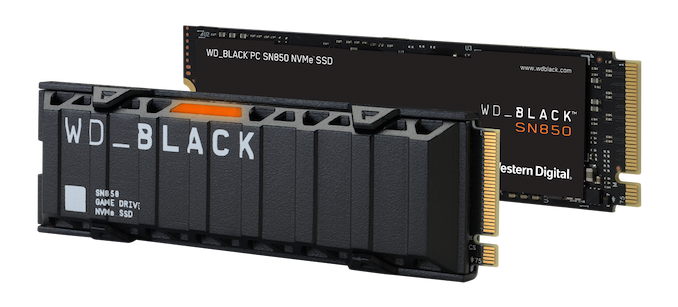The Western Digital WD Black SN850 Review: A Very Fast PCIe 4.0 SSD
by Billy Tallis on March 18, 2021 12:50 PM ESTConclusion
The Western Digital WD Black SN850 has clearly established itself as a premium consumer SSD. It trades the lead with the Samsung 980 PRO on many tests but beats Samsung more often than not, making the WD Black SN850 the fastest PCIe 4.0 SSD we have tested so far.
Western Digital was slow to get into the NVMe game and at times it has seemed like they weren't trying very hard to go after the high end. But they're definitely serious contenders now. The high-end consumer SSD market is no longer just Samsung and the runners-up.
Overall the SN850 does have a few performance quirks, but no serious weaknesses to worry about. The SN850 has a bigger and faster SLC cache than most of the competition and generally seems better-optimized for client workloads than the 980 PRO.
The SN850 also tends to have a bit better power efficiency than the 980 PRO, though the SN850 can definitely end up drawing a lot of power to deliver such high performance. Western Digital has sacrificed some of the efficiency from their previous-generation drives, so the heatsink option makes more sense than it did for the SN750. But the heatsink should be no means be viewed as mandatory. Only the most intense niche workloads will be able to keep the SN850 busy long enough for thermal throttling to become a serious limitation.
Samsung and Western Digital are also facing stiff competition from numerous brands that are using the Phison E18 SSD controller. We don't have full benchmark results from any of those yet, but preliminary results indicate that while there may be no clear winner for the absolute fastest consumer SSD, the Western Digital SN850 is holding on to most of its individual benchmark wins. Later this year we're expecting another wave of Phison E18 drives to arrive using 176L 3D TLC NAND, which may shift the balance.
Some enthusiasts have bemoaned the switch away from MLC NAND (2 bits per cell) for high-end drives. But the WD Black SN850 shows that high-end TLC (3 bits per cell) drives now match or surpass the performance of the Samsung 970 PRO on almost every single metric, even the corner cases where the TLC+SLC caching strategy traditionally runs into trouble. The only remaining test where that last high-end MLC drive still has a significant advantage is sustained sequential write speed after any SLC cache has been filled. For the very narrow range of workloads where that might matter more than the significantly higher peak performance modern consumer TLC drives offer, there are plenty of enterprise TLC drives that don't use SLC caching at all.
MLC is now dead, and there's no compelling reason to bring it back (except for niche applications).
| Premium NVMe SSD Price Comparison March 18, 2021 |
|||||||
| 500 GB | 1 TB | 2 TB | 4 TB | ||||
| WD Black SN850 (without heatsink) |
$119.99 (24¢/GB) | $199.74 (20¢/GB) | $379.99 (19¢/GB) | ||||
| ADATA XPG Gammix S70 | $199.99 (20¢/GB) | $399.99 (20¢/GB) | |||||
| Corsair MP600 PRO (Phison E18) |
$224.99 (22¢/GB) | $434.99 (22¢/GB) | |||||
| Sabrent Rocket 4 Plus (Phison E18) |
$199.99 (20¢/GB) | $399.98 (20¢/GB) | $799.99 (20¢/GB) | ||||
| Samsung 980 PRO | $119.99 (24¢/GB) | $196.74 (20¢/GB) | $379.99 (19¢/GB) | ||||
| Inland Performance (Phison E16) |
$94.99 (19¢/GB) |
$178.99 (18¢/GB) | $329.99 (16¢/GB) | ||||
| Sabrent Rocket 4.0 (Phison E16) |
$89.99 (18¢/GB) |
$149.98 (15¢/GB) | $299.98 (15¢/GB) | ||||
| PCIe 3.0: | |||||||
| SK hynix Gold P31 | $74.99 (15¢/GB) |
$134.99 (13¢/GB) | |||||
| WD Black SN750 | $62.99 (13¢/GB) |
$138.08 (14¢/GB) | $299.99 (15¢/GB) | ||||
| Samsung 970 EVO Plus | $79.99 (16¢/GB) |
$164.99 (16¢/GB) | $319.99 (16¢/GB) | ||||
The top-tier PCIe 4.0 SSDs are all priced very similarly right now, accurately reflecting that they all provide about the same real-world performance. Western Digital's current pricing for the WD Black SN850 is definitely competitive in this context. For a lot of consumers shopping in this segment, the decision may come down to heatsink options and aesthetics. The older, somewhat slower and less efficient generation of PCIe 4.0 SSDs based on the Phison E16 controller includes some much more affordable drives that are only a bit more expensive than the top PCIe 3.0 SSDs.
For most use cases a PCIe 4.0 SSD is still definitely overkill as it won't offer meaningfully better real-world performance than a good PCIe 3.0 SSD. PCIe 4.0 SSDs are still largely lacking their killer app, and saving something like $65 on a 1TB drive to drop down to PCIe 3.0 definitely has an impact on the rest of a system build's budget. But for consumers that are convinced they have good reason to upgrade to PCIe 4.0 storage, the WD Black SN850 is worthy choice. It offers the satisfaction and bragging rights of one of the fastest drives available, and will not be significantly outclassed until PCIe 5.0 arrives.











83 Comments
View All Comments
tech345 - Monday, April 19, 2021 - link
really it was great to use for everyonekensiko - Friday, April 30, 2021 - link
I'm pleased by the fact that you still include the Optane.PCIe 4.0 impresses but regarding endurance, 600TB is not impressive, so I'll keep my Optane for now. Too bad MLC is dead.
Wrathier - Monday, November 22, 2021 - link
I just bought one to use with my new Z690 build. Going to be awesome. I already have a 2TB Nvme m.2 Samsung 960 PRO I of course will keep as well, but will use this as "main drive". Seems awesome.